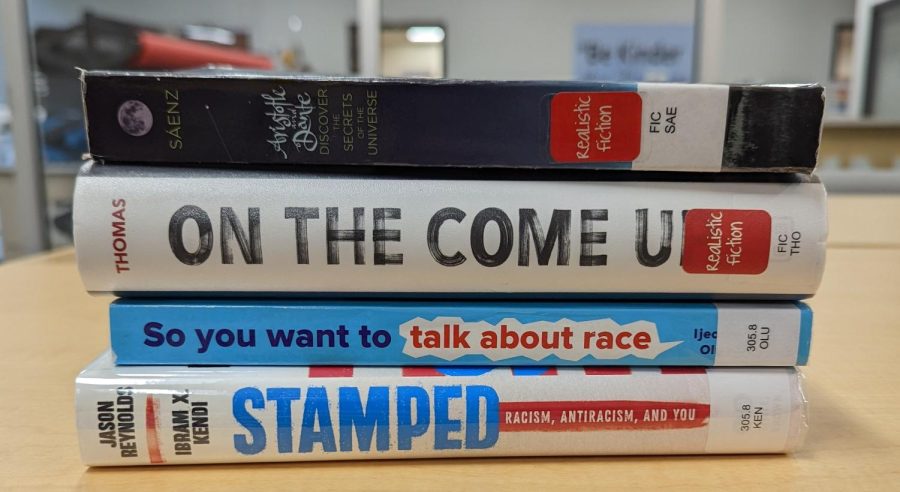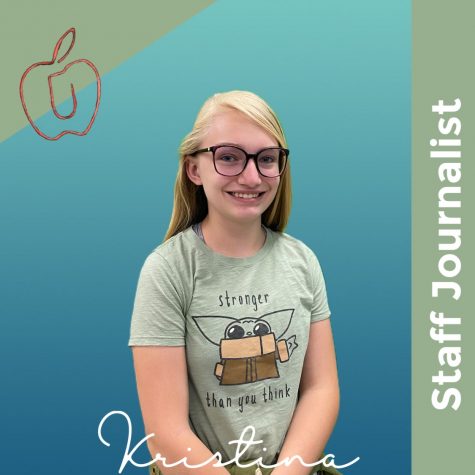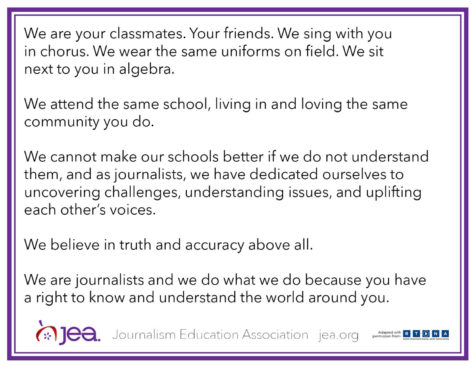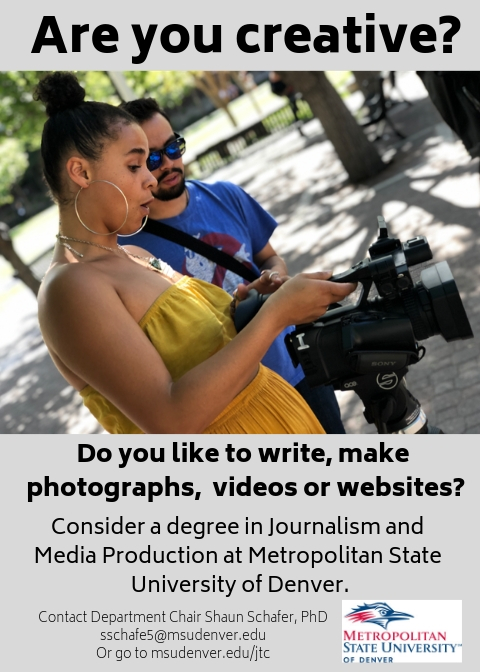It’s Time to Teach the Truth
We must prioritize teaching diverse and inclusive books and curriculums in our schools.
May 10, 2022
Ms. Binion is a language arts teacher at Broomfield high school. One of her main focuses is teaching a more diverse curriculum within her classes. “I think that we’ve always needed” more diverse books and curriculum taught in schools, Ms. Binion said.
She teaches a lot of diverse books with diverse characters — books like Aristotle and Dante Discover the Secrets of the Universe by Benjamin Alire Sáenz and The Absolutely True Diary of a Part-Time Indian by Sherman Alexie.
Both of those books are able to represent a more diverse section of kids. They both incorporate more diverse themes and characters — like LGBTQ+ characters and what it’s like to live on a Native American reservation. (Both of these books are incredible and I’d recommend you read them).
Delainy Harper, Lainy for short, is a Junior at Broomfield High School. She said, “My LA teacher currently, Ms. Binion, is doing phenomenally [at teaching diverse books].”
Why should we teach diverse books? An article by Jonda McNair, who has a PhD in Language, Literacy, and Culture from Ohio State University, said, “Having a diverse collection can support all students in finding titles that they can read and connect with on some level while affirming their own cultural identities and hopefully developing important positive insights about others.” Reading diverse books helps kids of different backgrounds feel more comfortable in the classroom.
Lainy has shared similar ideas to McNair’s article. Lainy said what she wants from a class is to feel “as though my experiences are being heard and I’m being represented.”
Mary Flannery, a writer for the National Education Association, said, “A good book can help you understand what it’s like for people who don’t share your race, religion, sexual orientation, or socio-economic status. Diverse books teach empathy.” Diverse books expose kids to different types of people and backgrounds that are different from their own. It’s important for kids and people to know other people’s backgrounds and stories.
Every student deserves to be represented in their classroom. Every student should have an understanding that white isn’t the only color. That straight isn’t the only sexual ornitation. That Christianity isn’t the only religion. That male isn’t the only gender.
Sometimes addressing these concepts through diverse books can be hard because it involves the discussion of sensitive subjects. A teacher may have very good intentions, but not all families are accepting of diverse characters, subjects, and texts. A solution may be posting teachers’ curriculum online so parents can see what they are teaching and potentially how they teach it.
Mr. Armbrustmacher, an ELA teacher, said, “Diversity in education has been the focus of many of our staff and department meetings this year. It’s also become a divisive topic politically, and frankly one that scares me a bit. You may have heard about the teaching of CRT [Critical Race Theory] or the 1619 Project, neither of which are actively pursued at Broomfield High School. At the center is the idea of exploring how race, and racism has shaped America. It’s become the topic of many educational debates and become a central talking point in school boards across the nation. Frankly, I’m fearful that a class discussion on race, as it applies to a specific time period demonstrated in a certain novel, may be misconstrued and create a fire-storm of unwarranted attention.”
According to Encyclopaedia Britannica, “Critical Race Theory is an intellectual movement and a framework of legal analysis according to which (1) race is a culturally invented category used to oppress people of colour and (2) the law and legal institutions in the United States are inherently racist insofar as they function to create and maintain social, political, and economic inequalities between white and nonwhite people.”
Both Mr. Davidson (another ELA teacher) and Mr. Armbrustmacher are hesitant to teach more diverse books because they both have fears about it. They are concerned that they will face backlash for simply addressing sensitive topics. They both want to address topics concerning diversity well and have good discussions. However, as Mr. Armbrustmacher said, teachers can receive “a fire-storm of unwarranted attention.”
Mr. Armbrustmacher and Mr. Davidson did bring a good point of being hesitant. But I don’t believe that being scared to teach more diverse books is a reason not to because we can’t eliminate those concerns. The only way to get more diverse books in classrooms is by working through the hardships and people’s backlash. If we don’t work to try to get more diverse books into classrooms and work through the challenges, then we are never going to see a change.
Lainy said that she has felt underrepresented by some books being taught in the classroom. “In other classes, reading Ernest Hemingway, that kind of stuff, like learning about how he’s an anti-Semite and I’m Jewish, just was not a great thing to be learning about.”
She also said that it wasn’t just English classes where she felt misrepresented: “It also goes over to social studies quite a bit. We’re in the middle of our Civil Rights unit in social studies. Of course, there’s a lot of not-so-great terms that are being used around that make me feel a little uncomfortable and unsafe.” Teaching diverse curriculums can make everyone in the classroom feel included, and it can teach students different types of situations people can be living in.
Rudine Sims Bishop published a piece called Mirrors, Windows and Sliding Glass Doors. She talks about why we need more diverse books. Bishop is often described as the “mother” of creating more diverse books for children. She said, “Literature transforms the human experience and reflects it back to us, and in that reflection, we can see our own lives and experiences as part of the larger human experience. Reading, then, becomes a means of self-affirmation.”
Students could see themselves in the books we are reading. Take Lainy, who is Jewish, she could see herself in a book that has a Jewish person in it. Students can get, according to Bishop, “self-affirmation” by reading a book which is important. It’s important that every student feels represented in that way.
Lainy is not the only student who feels unrepresented or misrepresented. There are many like her, and it needs to change. We need to get more diverse books taught in the classroom curriculum and make sure that teachers teach them in a beneficial and respectful way.
Some of the language arts teachers here do not teach a very diverse curriculum within their course. But many want to. The teachers lack the proper training in how to teach diverse books. Mr. Davidson and Mr. Garner both teach similar books. They both teach 9th grade English and teach books like Lord of the Flies and Shakespearian plays.
Mr. Davidson said the reason he teaches the books he does: “I try to teach stories that also have cross-curricular content.” He wants to teach his students to read literature like an English professor. Mr. Garner said that he likes to look at books with different government types and that can affect a society because he also teaches government.
Mr. Davidson also mentioned that BVSD hasn’t prepared teachers for certain kinds of instruction: “I see in the district that we haven’t […] received any training. So, what would be really good titles to work with? And how do I go about that? And how to be sensitive and think about minorities in the classroom and how they receive that? And do they feel even more isolated because we’re doing that kind of thing? So, we just don’t receive that training.”
If teachers had proper training in how to teach diverse books, then it could happen more. Ms. Binion said that even she gets parent backlash. “I have indeed–almost every year [received backlash] but the administration, at both our school and the district, are supportive of diversity and representation in literature and have always supported me.” Ms. Binion has been supported by the district and the school, but other teachers may not have had the same experience.
Now more than ever, it is critical that we prioritize the teaching of diverse books and curriculums.






